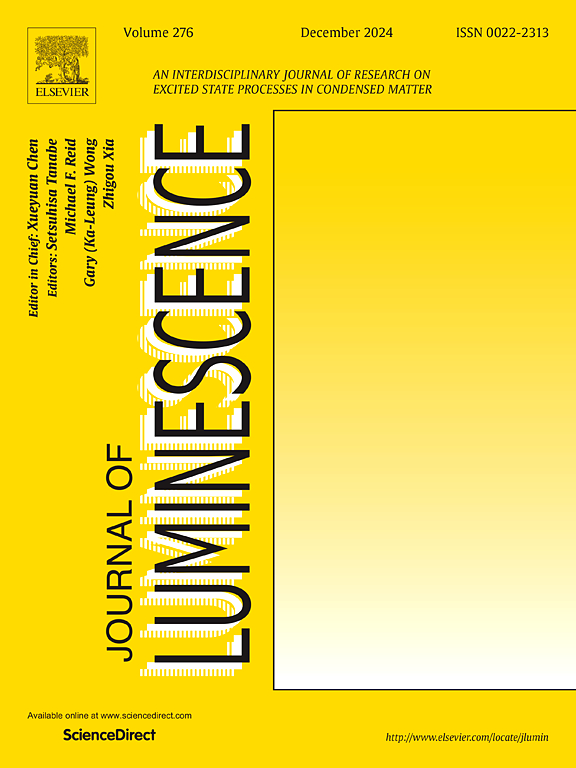全无机锡基钙钛矿纳米晶体与RhB发色团之间的超快能量转移
IF 3.6
3区 物理与天体物理
Q2 OPTICS
引用次数: 0
摘要
本研究探讨了基于CsSnBr3纳米晶体和Rhodamine B (RhB)发色团的杂化物在可见光激发下的能量转移机制。利用稳态和时间分辨光致发光以及飞秒瞬态吸收光谱全面研究了RhB染料向CsSnBr3提供能量的能力。在纳米晶-发色团杂化中,RhB单重态激发态的光敏化速率常数为4.3 × 109 s−1,Förster共振能量转移(FRET)占主导地位(85.1%)。这些发现揭示了能量转移机制,并强调了基于CsSnBr3纳米晶体和有机发色团的光收集装置的设计。本文章由计算机程序翻译,如有差异,请以英文原文为准。
Ultrafast energy transfer between all-inorganic tin-based perovskite nanocrystals and RhB chromophore
This study explores the energy transfer mechanisms through visible-light excitation of hybrids based on CsSnBr3 nanocrystals and Rhodamine B (RhB) chromophores. The ability of RhB dyes to donate energy to CsSnBr3 is comprehensively investigated with steady-state and time-resolved photoluminescence, as well as femtosecond transient absorption spectroscopy. The Förster resonance energy transfer (FRET) dominates (85.1 %) the photosensitization of the singlet excited state of RhB in the nanocrystal-chromophore hybrids with a rate constant of 4.3 × 109 s−1. These findings reveal the energy transfer mechanism and highlight the design of light-harvesting devices based on CsSnBr3 nanocrystals and organic chromophores.
求助全文
通过发布文献求助,成功后即可免费获取论文全文。
去求助
来源期刊

Journal of Luminescence
物理-光学
CiteScore
6.70
自引率
13.90%
发文量
850
审稿时长
3.8 months
期刊介绍:
The purpose of the Journal of Luminescence is to provide a means of communication between scientists in different disciplines who share a common interest in the electronic excited states of molecular, ionic and covalent systems, whether crystalline, amorphous, or liquid.
We invite original papers and reviews on such subjects as: exciton and polariton dynamics, dynamics of localized excited states, energy and charge transport in ordered and disordered systems, radiative and non-radiative recombination, relaxation processes, vibronic interactions in electronic excited states, photochemistry in condensed systems, excited state resonance, double resonance, spin dynamics, selective excitation spectroscopy, hole burning, coherent processes in excited states, (e.g. coherent optical transients, photon echoes, transient gratings), multiphoton processes, optical bistability, photochromism, and new techniques for the study of excited states. This list is not intended to be exhaustive. Papers in the traditional areas of optical spectroscopy (absorption, MCD, luminescence, Raman scattering) are welcome. Papers on applications (phosphors, scintillators, electro- and cathodo-luminescence, radiography, bioimaging, solar energy, energy conversion, etc.) are also welcome if they present results of scientific, rather than only technological interest. However, papers containing purely theoretical results, not related to phenomena in the excited states, as well as papers using luminescence spectroscopy to perform routine analytical chemistry or biochemistry procedures, are outside the scope of the journal. Some exceptions will be possible at the discretion of the editors.
 求助内容:
求助内容: 应助结果提醒方式:
应助结果提醒方式:


